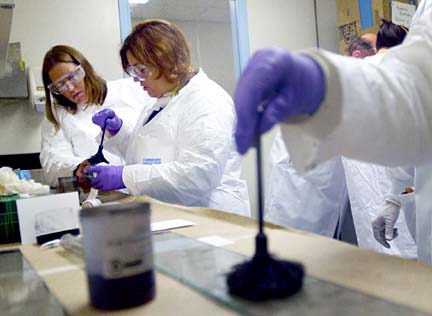
GEORGE F. LEE / GLEE@STARBULLETIN.COM
Science teachers Sara Staniewicz, above left, of Holy Family, and Jessica Carew, of La Pietra, learned techniques of police science yesterday in the crime lab at the Honolulu Police Department.
Isle teachers will take
what they learn in the
HPD lab back to students
Big Island teacher Malia Lee examined the severed ear of a dead pig and meticulously spread a fine black dust in search of any trace of fingerprints.
CORRECTION
Friday, June 27, 2003>> Cheryl Langlais, of Niu Valley Middle School, was pictured learning the techniques of police science in a Page A3 photo Tuesday. The caption misidentified her as Jessica Carew.
The Honolulu Star-Bulletin strives to make its news report fair and accurate. If you have a question or comment about news coverage, call Editor Frank Bridgewater at 529-4791 or email him at fbridgewater@starbulletin.com.
She held up the blotting paper used to soak up oils left by a finger on the pig's ear and smiled as the clear outline of a fingerprint appeared.
"You know, the life span of a fingerprint on a corpse is only 24 hours," said the Laupahoehoe high school teacher.
Lee and 11 other high school teachers from Oahu, Maui and the Big Island are spending this week in the forensics lab of the Honolulu Police Department as part of its course "Forensics for Teachers." The teachers are learning to collect fingerprints and DNA, identify firearms and work with all types of evidence to bring forensic science to their classrooms.
"Oh, it's just like the television show 'CSI,'" Lee said. "It's so exciting."
HPD evidence specialist Clarence Fraser, who is helping teach the class, said the goal is to get "kids interested in science and show how it can be interesting."
GEORGE F. LEE / GLEE@STARBULLETIN.COM
HPD Evidence Specialist Clarence Fraser measured a powdered breakfast drink, showing that different substances can be used as fingerprint powder.
"We brought high school students in last year, but we figured we could reach more students by teaching the teachers," he said.
Lee plans to take what she learns and set up a criminal investigation in her classroom.
"We're going to look at Shakespeare's 'Macbeth' and discover who killed him by collecting and analyzing all the evidence," she said.
She hopes to pair science with literature by working with the English teachers to bring an integrated curriculum to the school, she said.
"For me, to do this is just so great. The kids are country kids, and they only go fishing and surfing," Lee said. "Now I can bring the fun elements of science to them."
Before school was out, she convinced her 11th-graders to take physics next year so they could learn to do the "CSI stuff." These are the kids who would not have taken the class otherwise, she said.
Lee was surprised to learn that the experiments could be duplicated in her classroom without going over her budget. For example, criminal investigators do not take advantage of digital cameras at crime scenes, she said.
"They use the regular film cameras and lenses to do photo analysis," Lee said. "Those are cheap, and we can buy them to do the same thing."
Fraser said, "We are trying to show them (teachers) how to do the labs with materials they can afford."
He pointed to a $7,000 alternative light source used to identify bone fragments buried in ashes or dirt. Teachers can use a simple blue-bulb flashlight instead, he said.


